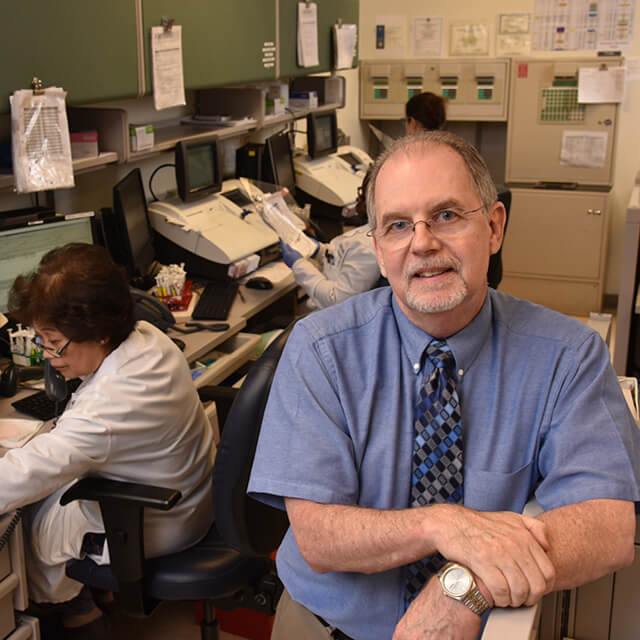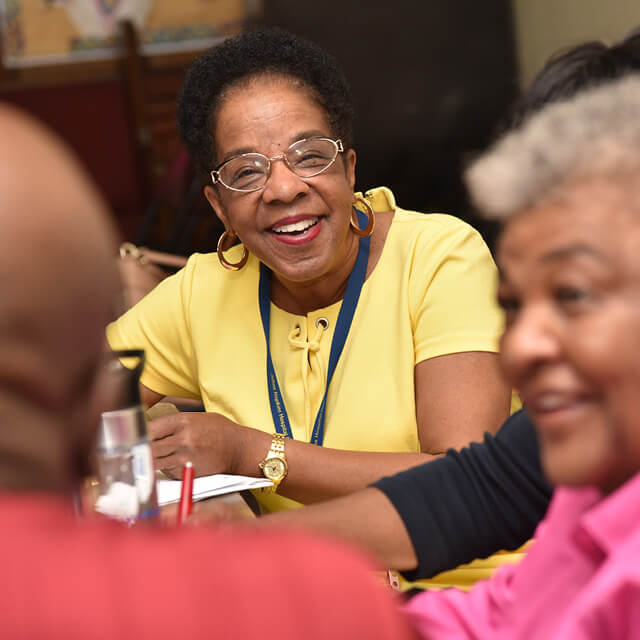Last April, Johns Hopkins geneticist and pediatrics professor Barbara Migeon published a journal article that offers an explanation for why more babies are born male than female. She says the topic has been on her academic mind for a long time.
How long?
“About 40 years,” she laughs.
Migeon, 86, continues to teach, research and publish. She’s part of a growing number of Johns Hopkins staffers who, despite their eligibility to retire, aren’t ready to hang up their blue and gold ID badges just yet.
As the baby boom generation reaches the age when retirement becomes an option, many workers age 66 and older are staying in the workforce. Whether by choice or by necessity, more Americans are working later into their lives.
According to a Pew Research Center breakdown of 2016 data from the federal Bureau of Labor Statistics, nearly 20 percent of Americans 65 and older are still working, up from about 13 percent in 2000.
The workforces at The Johns Hopkins Hospital and the Johns Hopkins University School of Medicine reflect that trend. Human resources data show that, between 2007 and 2016, the number of full-time workers 66 and older employed by The Johns Hopkins Hospital increased from 81 to 169, or from 1 to 1.8 percent of hospital staff. At the Johns Hopkins University School of Medicine, the number more than tripled to 379—representing 4.3 percent of the staff.
Experts say that, while economic concerns play an undeniable role in retirement decisions, many other factors are at play.
“For a lot of people at institutions like Johns Hopkins, identity is very much a part of working later in life,” says Jacquelyn James, co-director of The Center on Aging & Work at Boston College. James has studied older workers in hospitals and higher education.
Migeon has been at Johns Hopkins for 61 years and founded the school of medicine’s Ph.D. program in human genetics in 1978.
“I still get a big kick out of what I do,” she says. “I’m able to work, so why wouldn’t I?”
Migeon ran a genetics research lab at Johns Hopkins until 2003, when her NIH grant ended.
“The world is different than it was when I began this work,” she says. “I don’t need an active lab to do research. There are all these wonderful databases now that we can explore for our work.”
After plumbing one of those databases, Migeon published her more-males-born-than-females article in the journal PLOS ONE. Migeon and her colleagues propose that female embryos that duplicate a specific region of a particular chromosome do not survive. Her long career as a leader in the field of genetics has yielded many such discoveries.
Migeon points to Johns Hopkins students as a source of inspiration that helps fuel her desire to work.
“I have lunch almost every day with graduate students,” Migeon says. “We learn from each other, and we share a real drive to know more. It’s a wonderful environment.”
She says her job has also allowed her to do things many people wait until retirement to do.
“You hear people say that they’re going to travel when they retire,” she says. But having spent decades discussing her work at genetics conferences in Paris, Berlin, Venice and many other great cities, “I’ve been fortunate to be able to do a lot of traveling for my job,” Migeon says.
Though the percentage of post-retirement-age staffers is higher among employees of the school of medicine than the hospital, the trend of working past retirement age is by no means limited to faculty.
 Michael Engelstad, 67, right, began his career as a medical technician at The Johns Hopkins Hospital in 1975, when lab tests were performed and delivered by hand.
Michael Engelstad, 67, right, began his career as a medical technician at The Johns Hopkins Hospital in 1975, when lab tests were performed and delivered by hand.
Today, he supervises the Critical Care Laboratory, which provides the hospital’s pediatric and adult intensive care units with around-the-clock results for blood tests such as hemoglobin and blood gases.
“I love what I do and I’m proud of the work we do at Johns Hopkins,” says Engelstad. “The longer I’m here, the more I realize how important this work is.”
Engelstad’s career began in the hospital’s Carnegie Building before moving to the basement of Meyer. Today, the lab is on the fifth floor of the Sheikh Zayed Tower, nestled conveniently among the units it serves.
He believes that baby boomers, and older workers in general, often have a useful perspective that comes only from years on a job. “You could look at what we do in the Critical Care Lab as just a process,” he says. “But I think there’s no substitute for the experience of knowing why that process is in place.”
Engelstad schedules three shifts of laboratory staff and knows which technicians are strongest in which skills and specialties. He says the lab’s goal is a 15-minute turn-around of results. After 41 years in a high-pressure job where a mix-up could be catastrophic, Engelstad says he’s considered retirement.
“But I feel great, I have a lot of energy and I enjoy coming to work,” he says.
Engelstad is part of one of the fastest-growing segments of post-retirement age staffers at Johns Hopkins: The number of hospital employees between the age of 66 and 70 doubled to 132 from 2007 to 2016.
That age group is growing even faster in the school of medicine, increasing from 84 in 2007 to 284 in 2016.
“Productivity is what matters,” says Inez Stewart, senior vice president of human resources at Johns Hopkins Medicine. “Just because a person is a certain age doesn’t mean that person is no longer useful or productive.”
University human resources vice president Heidi Conway says the full-time statistics don’t begin to reflect the many older employees who choose to continue working part-time hours.
The last 10 years, Conway says, have changed traditional views of retirement. The economic recession of the late 2000s, she says, forced many workers to adjust their long-term plans.
“We’ve had numerous employees transition to retirement gradually,” she says. “They have experience and institutional knowledge that we don’t want to lose. It’s so valuable when they can stay a while longer and share it.”
Tay McNamara, co-director at Boston College’s Center on Aging & Work, says people with academic jobs tend to work longer than people whose jobs regularly demand more physical labor.
McNamara says that, as people live longer and healthier lives, many find they still have the drive to continue their careers as they get older. “People are not experiencing age the way they used to,” she says. “While it’s not universal, they’re more likely to still be quite healthy at 66 and look at a long future of work.”

Take community health administrator Adrian Mosley, 66, right, who started at Johns Hopkins as a pediatric social worker in 1979. Since 1994, she has served as a liaison to East Baltimore, running programs such as Faith and Food, a six-week nutrition-education program that Mosley offers through Bible-study groups at African-American churches. Her years at Johns Hopkins have allowed her to define and sculpt her own position to meet the needs of the neighborhoods and communities she serves.
“My career is just so fulfilling,” she says. “It’s great to know that God’s purpose for my life also happens to be my job.”
See also:
